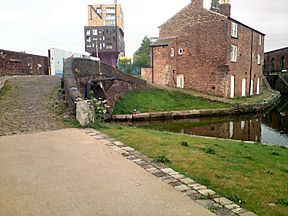Islington Branch Canal facts for kids
Quick facts for kids Islington Branch Canal |
|
|---|---|

The towpath bridge over the entrance to the Branch
|
|
| Specifications | |
| Status | part extant |
| Navigation authority | British Waterways |
| History | |
| Original owner | Ashton Canal Company |
| Geography | |
| Branch of | Ashton Canal |
The Islington Branch Canal was a short waterway in Ancoats, north-west England. It connected to the main Ashton Canal between its first two locks. This branch canal was very important for local industries.
Contents
History of the Islington Canal
Even though it was only about 945 meters (1,034 yards) long, this canal branch was super important. It helped many factories and businesses move their goods. The canal had no locks, making it easy for boats to travel. It was used a lot during its working life.
Along its banks, you could find wharves for coal, sand, and salt. There was also a wharf for scrap metal. Many different factories used the canal. One interesting place was Molineux, Webb, & Company’s Glass Works. They made beautiful flint glass products right at the end of the branch.
Around 1801, a man named Samuel Oldknow helped build some lime kilns. These kilns were used to burn limestone. The limestone was brought along the Peak Forest Canal. We think these kilns might have been near Limekiln Lane on this branch.
The canal started at the Ashton Canal and went north-west. It then passed under Mill Street. After the bridge, it made a sharp turn. Then it continued towards the north-east. The canal was used until the 1950s. By then, parts of it were falling apart. But some of it is still open today. British Waterways even has a yard there now.
Industries Along the Canal
The Islington Branch Canal was a busy place. Many different businesses used its waters. They shipped raw materials in and finished products out.
Early Businesses (1850s)
In 1851, there were coal wharves on both sides of the canal. These were near the Ashton Canal junction and Mill Street bridge. These wharves had weighing machines for the coal. Further along, the west bank had a cotton mill and more coal wharves. The east bank had a fire brick yard and more coal wharves. There was even a small side arm of the canal.
Beyond the side arm, the west bank had a dye works. There was also a dockyard with a dry dock for repairing boats. The end of the canal was a large basin. The Manchester Flint Glass Works was located there. The eastern side of the basin was a brick field. Here, clay was dug out to make bricks.
Changes Over Time (Late 1800s to Mid-1900s)
By 1891, the empty area near the junction became the Albion Spindle Works. Later, it was home to a toy balloon factory and a chain factory. The chain factory was gone by 1950. An engineering works then took its place. A paint works also took up most of the west side wharves.
The area between Mill Street bridge and the side arm also changed. By 1891, it had a wire works. This factory even had a small tramway! The side arm of the canal was filled in. Later, an engineering works and a clothing factory were there. The engineering works made lift equipment in the 1950s.
The brick field by the basin became a Bedstead and Safe Works by 1891. An electric engineering works and a church were also built there. The glass works grew bigger, covering the old docks. The large basin became a narrow channel. By 1951, a shirt factory, a garage for the city's cleaning department, and another engineering works were there. This engineering works did cylinder grinding and welding. By the 1970s, the whole area north of Mill Street bridge had been rebuilt.

